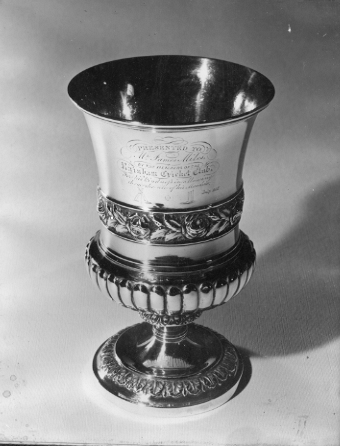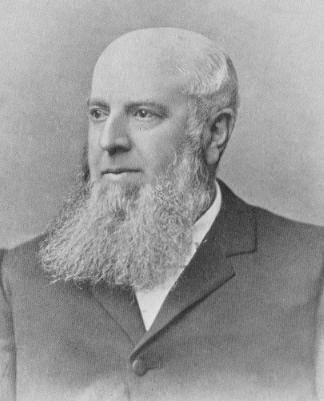Richard Wakeley and the Founding of Rainham Cricket Club in 1856
Born at Moor Street Farm in 1832, Richard Mansfield Wakeley entered the family farming business and became the farm manager during the 1850s. He also excelled as a cricketer and played for Gore Court at their old Bell Road ground in Sittingbourne from 1855 to 1856. He left the Sittingbourne club in 1856 and with the assistance of fellow Rainham farmer Thomas Dodd, gathered together a group of interested local Rainham men, trained them in the art of cricket and formed Rainham Cricket Club. The players were drawn from different occupations and backgrounds.
Thomas Stanley Wakeley worked as a corn merchant, James Atkins, a malster, William Burley, a tailor, William Moss, a grocer and draper, Charles Rich, James Mansfield, Thomas Dodd, Edward Dodd and James Miles, farmers and George Dodd and John Stevens, farm workers. All these men resided in Rainham.
James Miles, the owner of Siloam Farm in Rainham allowed the newly formed club the use of his meadow, situated in Chapel Lane (now Mierscourt Road) opposite the present day Primary school and this became known as ‘James Miles Meadow.’ According to the ‘East Kent Gazette’ dated July 18th 1857, Rainham Cricket Club awarded him a silver cup at one of their quarterly meetings with the inscription:
Presented to Mr. J Miles, by the members of the Rainham Cricket Club, for his kindness in allowing them the use of his meadow. July 1857.
A photograph of the cup still hangs on the wall of the present Rainham clubhouse. The actual cup was brought to the ground in 1957 during the club’s centenary season (celebrated one year late) by James Miles grandson. From that time until recently the cup remained in the vault of the Midland Bank in Rainham but when the bank closed the cup went missing and has not been traced.

It isn’t clear how long Rainham Cricket club played at Siloam Farm but they had stopped playing there by 1883 when the owner James Miles sold the farm. The club then had to play on numerous grounds, including Berengrove Park by courtesy of Mr. William Walter the owner until a permanent venue at Rainham Recreation Ground was obtained in 1890. When Richard Wakeley junior took possession of Siloam Farm the club returned there for several seasons during the period 1902 to 1910.
According to the ‘Rochester Gazette’ dated July 8th 1856, the first match involving Rainham Cricket Club took place against the Angel Club Strood on Wednesday July 2nd 1856 at Siloam Farm and after a close game they lost. They played other local clubs in the area and these included Gore Court, Milton, Selling, Throwley and the Star Club Rochester. After home matches the teams went to the ‘White Horse’ pub in Rainham High Street for tea and entertainment provided by the publican and host Mr. Conningsby whose name also appeared on some scorecards.
Richard Wakeley became the team captain in 1856 and stood out in the side as an all-rounder. He took five wickets in the club’s first game against the Angel Club Strood. He also helped to build up the strength of the club until Rainham became one of the strongest clubs in the area by the end of the decade.
Richard Wakeley played regularly during the 1850s before going to the Royal College of Agriculture in Cirencester where he represented the college cricket team. Unfortunately, without his services and influence Rainham deteriorated in strength during the 1860s. After his marriage in Cirencester in 1867 he returned to Rainham where he maintained his links with the club up to his death in 1907 both as a player then as a vice-president. Two of his sons Seymour and Richard Mansfield Wakeley junior later played for the club.
Apart from his cricketing ability Richard Wakeley had strong religious convictions and served as pastor at Providence Chapel in Orchard Street which his family had built. He also served as a local politician and a Guardian of the Parish. According to his obituary in the ‘East Kent Gazette’ in September 1907 he remained a kind hearted and generous benefactor to the people of Rainham during his lifetime. In his later years he wrote a book entitled ‘Gathered Fragments,’ a profile of his brother Thomas Stanley Wakeley.
As a farmer and employer in the parish Richard Wakeley became very well-known and instrumental in the establishment of ‘Wakeley Brothers’ fruit and hop growing business which existed until recently in the Rainham area.
League cricket didn’t exist when Rainham Cricket Club first started and it wasn’t until 1896 when the club joined the Chatham & District League that they had their first taste for one season. The games played before this were friendly social matches which usually took place on Saturdays and Wednesdays.
On August 3rd, 1858 the ‘Kentish Gazette’ reported a match played on July 28th:
On the 28th past a match was played between the gentlemen of Throwley and eleven of Rainham on the Belmont ground, the residence of Thomas Townsend esq, whose hospitality to the players on this and former occasions has been such as to merit their rarest acknowledgement.
As in recent times the players retired to a pub for a drink after matches and sometimes had a few too many as Richard Wakeley pointed out in his book ‘Gathered Fragments’ where he wrote that after one match near Sittingbourne during the late 1850s his brother, Thomas Stanley Wakeley, challenged the team to a race back to Rainham. With Wakeley in his personal horse and trap and the other players in a horse drawn coach the race took place which Thomas Stanley Wakeley won after which he gave the reins to his driver and then laid down in the back of the trap and fell asleep on the last part of the journey home.

Photo of TS Wakeley, Rainham Cricket Club
The Wakeley family had a big influence on Rainham Cricket Club from 1856 to 1910 with six members of their family playing and three of these R. M Wakeley, T. S. Wakeley and R. M. Wakeley Junior holding the captaincy for periods of time. They also furthered the interests of the club through the local parish council contributed a ground at Siloam Farm and maintained the pitch at Rainham Recreation Ground when the cricket club played there. Wealthy Rainham farmer Sid Callaway later patronized Rainham Cricket Club right up to the late 1980s.
The game of cricket played by Rainham in 1856 more or less resembled the game today, including the length of the wicket, the size and shape of the bats and the weight of the ball, although there were a few differences. Firstly, an over consisted of four and not six deliveries but when there was a change of bowling the new bowler was allowed to have two practice deliveries at the batsman before the statutory four deliveries in his first over. Bowlers could also bowl underarm which ceased at the end of the 19th century.
Today, Rainham is a much bigger club than when it first formed with three teams turning out on a Saturday and two on a Sunday with an assortment of boy’s teams playing midweek. The First and Second XIs play in the Shepherd-Neame Kent County League and home matches are played at Berengrove Park.










































































































































